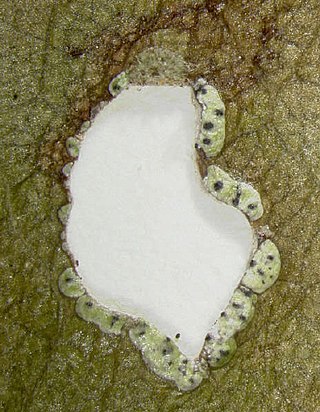
Lecania is a genus of lichenized fungi in the family Ramalinaceae. The genus was circumscribed by Abramo Bartolommeo Massalongo in 1853. Lecania is widely distributed, especially in temperate regions, and contains about 64 species.

Porina is a genus of lichens in the family Trichotheliaceae. A 2020 estimate places about 145 species in the widespread genus.

Micarea is a genus of lichenized fungi in the family Pilocarpaceae. The widely distributed genus contains 126 species and new species are described actively. Species in the genus are crustose lichens and their photobiont is a single-celled green alga.

Amandinea is a genus of lichenized fungi in the family Caliciaceae. Genetic studies indicates that the genus Amandinea and Buellia are the same, although this is not widely accepted.

Arthothelium is a genus of lichenized fungi in the family Arthoniaceae.

Anisomeridium is a genus of lichens in the family Monoblastiaceae. The type species was originally named Arthopyrenia xylogena by Swiss botanist Johannes Müller Argoviensis in 1883; in 1928, Maurice Choisy defined the genus Anisomeridium, designating A. xylogena the type species.
Thelocarpon is a genus of fungi in the family Thelocarpaceae.

Gyalecta is a genus of lichen-forming fungi in the family Gyalectaceae that contains 50 species. Gyalecta was circumscribed by lichenologist Erik Acharius in 1808.

Absconditella is a genus of lichenised fungi in the family Stictidaceae. The genus was circumscribed in 1965 by Czech lichenologist Antonín Vězda, with Absconditella sphagnorum assigned as the type species. Absconditella is characterised by gyalectoid apothecia with a hymenium that is not amyloid, without a dark pigment and thalli containing green algae as photobionts. The genus name means "hidden", a reference to the scant structure of the thallus and its small apothecia.
Polymeridium is a genus of lichen-forming fungi in the family Trypetheliaceae. Species in the genus are corticolous (bark-dwelling) and typically occur in tropical areas.
Arthopyrenia is a genus of fungi in the family Trypetheliaceae. It was formerly classified in the eponymic family Arthopyreniaceae, but molecular phylogenetics studies showed that the type species, Arthopyrenia cerasi, was a member of the Trypetheliaceae.

Catillaria is a genus of crustose lichens in the family Catillariaceae. The genus was circumscribed by Italian lichenologist Abramo Bartolommeo Massalongo in 1852. It is the type genus of Catillariaceae, which was circumscribed by Austrian lichenologist Josef Hafellner in 1984.

Strigula is a genus of lichen-forming fungi in the family Strigulaceae. The genus was circumscribed in 1823 by English mycologist Elias Magnus Fries.

Halecania is a genus of fungi in the family Leprocaulaceae. It has 22 species. The genus was circumscribed by Austrian lichenologist Michaela Mayrhofer in 1987, with Halecania alpivaga assigned as the type species. She created Halecania to contain species, formerly placed in Lecania, with the following characteristics: uniformly amyloid apical domes, paraphyses with dark brown apical caps, and halonate ascospores.
Swinscowia is a genus of lichen-forming fungi in the family Strigulaceae. It has 34 species. Swinscowia was proposed in 2020 by lichenologists Shu-Hua Jiang, Robert Lücking, and Emmanuël Sérusiaux to contain non-foliicolous species that were isolated from bark and rocks. Swinscowia jamesii, a species that was originally described in genus Geisleria, and later transferred to Strigula, is the type species of the genus. The genus name honours British lichenologist Dougal Swinscow, who originally described the type species in 1967.
Protothelenella is a genus of fungi in the family Protothelenellaceae. It contains 11 species, some of which form lichens. Protothelenella species have a crustose thallus with spherical to pear-shaped, dark brown to blackish perithecia. Microscopic characteristics of the genus include bitunicate asci with an amyloid tholus, and ascospores that are colourless and contain multiple internal partitions. Some species grow on acidic substrates including rocks, soil, bryophytes, plant detritus or rotten wood. Other species are lichenicolous (lichen-dwelling), growing on species of Solorina, Peltigera, Pseudocyphellaria, or Cladonia.











